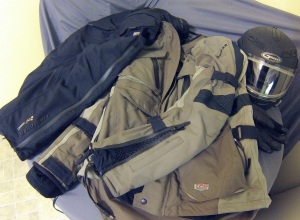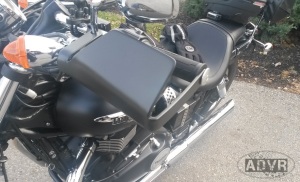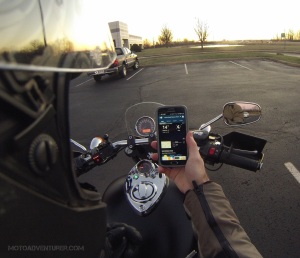 Turn the key. Pull in the clutch. Thumb the ignition.
Turn the key. Pull in the clutch. Thumb the ignition.
Wait… what?
Did I mention “unconventional”?
Look, countless articles have been written on winterizing your motorcycle. This time of year it’s the same old song, clean up the bike, protect the chrome, put Sta-Bil in the tank, put the battery on a tender, cover the bike, put it on a lift…
Here’s my unconventional advice (But only for the most dedicated):
 Spend $600 on dependable cold weather gear
Spend $600 on dependable cold weather gear
- I’ve discussed my kit at length, but waterproof jacket, pants, winter boots, full face helmet, neck gaiter, and winter gloves are a must.
Spend $100 on Heated Grips.
- Good gloves will take you to about freezing in my experience, if you want to ride as the mercury plummets, it’s time to get some extra heat.
- I run WeatherBug on my phone all summer, but when winter comes around, I typically check the weather on multiple platforms to make sure I don’t get stranded in the snow.
Ride. The. Motorcycle.
- Repeat as necessary.
Bonus items:
Get a tall windscreen or a fairing
- Cutting wind is key, the more the better
 Hand Guards or Hippo Hands
Hand Guards or Hippo Hands
- Heated grips are good, but keeping the wind off your hands is even better. My hands are typically the first thing that gets cold, but if I plan right, only a little, and typically the only my fingertips.
Break the bank on an Aerostich riding suit
- There’s some intense riding gear out there. I don’t have an “stich” yet, but the faithful will back up their credentials.
Get some heated liners for you jacket, pants, and gloves
- Heated gear is incredible, being comfortable makes all the difference; from being more alert to looking forward to the next ride despite the cold.
 This plan isn’t fool proof, and absolutely not without pitfalls. Salt, water main breaks, unsuspecting drivers, and cold rubber, all things to be avoided, and above all, riding on two-wheels in the snow is a no-go, even for me. Despite all that, you’re going to be grounded at some point (Snow or excess salt). I hit that impasse yesterday morning as the second January snowfall started coming down. In the interim, put some Sta-Bil in the tank and keep it covered while you wait out the storm. As mentioned in the conventional advice, I recommend starting the bike and running it through a full heat cycle from time to time. Avoid short idles as they can cause moisture inside the block from condensation; run the bike (preferably ride) long enough to get the engine good and hot to burn off any moisture in the engine or the pipes. With a little luck, you’re probably only going to be off the road for a couple weeks (it was about 5 weeks back in 2014).
This plan isn’t fool proof, and absolutely not without pitfalls. Salt, water main breaks, unsuspecting drivers, and cold rubber, all things to be avoided, and above all, riding on two-wheels in the snow is a no-go, even for me. Despite all that, you’re going to be grounded at some point (Snow or excess salt). I hit that impasse yesterday morning as the second January snowfall started coming down. In the interim, put some Sta-Bil in the tank and keep it covered while you wait out the storm. As mentioned in the conventional advice, I recommend starting the bike and running it through a full heat cycle from time to time. Avoid short idles as they can cause moisture inside the block from condensation; run the bike (preferably ride) long enough to get the engine good and hot to burn off any moisture in the engine or the pipes. With a little luck, you’re probably only going to be off the road for a couple weeks (it was about 5 weeks back in 2014).
 While you may be “crazy” among acquaintances, and probably even friends, I believe there are advantages to riding through the winter. For one, it keeps your skills sharp. Many riders break from November until March; but “Rider Focus”, like algebra, is a perishable skill, lost over months of riding in the stagnant car. Short rides through the winter help shallow out the learning curve come spring. I’m also a firm believer that like airplanes, sitting idle is actually bad for a motorcycle. Routinely running the engine gets oil circulated over the essential parts, and helps burn moisture out of the crankcase, keeps the seals from dry-rotting, etcetera, etcetera.
While you may be “crazy” among acquaintances, and probably even friends, I believe there are advantages to riding through the winter. For one, it keeps your skills sharp. Many riders break from November until March; but “Rider Focus”, like algebra, is a perishable skill, lost over months of riding in the stagnant car. Short rides through the winter help shallow out the learning curve come spring. I’m also a firm believer that like airplanes, sitting idle is actually bad for a motorcycle. Routinely running the engine gets oil circulated over the essential parts, and helps burn moisture out of the crankcase, keeps the seals from dry-rotting, etcetera, etcetera.
 I realize this advice is not for everyone. Ohio is a very strange place, while “vanilla” in my opinion, the weather here can easily swing from summer to winter in about 24 hours, if not faster. I’ve played ice hockey in 72 degree weather in December, it was 7 degrees earlier this week, and I managed to ride the bike Saturday when just above freezing. The locals often say “Don’t like the weather? Wait a few hours, it’ll change”. The line in the sand is different for everyone, over 40F is typically my Dad’s rule, and I’ve met other guys that ride as long as the roads are dry and it’s above freezing. But If you’re not comfortable, it’s not fun, and there’s no shame in that. All I am saying is that there is an alternative when it comes to winterization, if you have the means, and the passion…. Ride the bike…
I realize this advice is not for everyone. Ohio is a very strange place, while “vanilla” in my opinion, the weather here can easily swing from summer to winter in about 24 hours, if not faster. I’ve played ice hockey in 72 degree weather in December, it was 7 degrees earlier this week, and I managed to ride the bike Saturday when just above freezing. The locals often say “Don’t like the weather? Wait a few hours, it’ll change”. The line in the sand is different for everyone, over 40F is typically my Dad’s rule, and I’ve met other guys that ride as long as the roads are dry and it’s above freezing. But If you’re not comfortable, it’s not fun, and there’s no shame in that. All I am saying is that there is an alternative when it comes to winterization, if you have the means, and the passion…. Ride the bike…


All true! Heated grips are a godsend! As my mum would say, ‘There’s no such thing as bad weather, just bad clothes!’
LikeLiked by 1 person
Your mum was wise indeed!
LikeLiked by 1 person
Well said – must order some hand guards!
LikeLiked by 1 person
I like heated grips, but I like heated glove liners and mid weight waterproof gloves better. I’ve never used heated leggings but a heated jacket liner makes a lot of sense with a good waterproof jacket and pants. Obviously the extremities get it first and keeping the core warm alleviates a lot of that. I like glove liners and midweight gloves as they retain a higher level of feel for the machine. Good article Drew.
LikeLiked by 1 person
All good point Gerry, I’m actually running both gloves and grips. The grips alone just aren’t hot enough, in fact they’re still not enough below 24F. Thanks for reading!
LikeLiked by 1 person
Points* (android auto-correct is wonderful…)
LikeLike
After many years of this approach, we decided to winter on the Gulf of Mexico. New method is adding 5gl of $1.67 gas every day or two! USbyus2016.com
LikeLiked by 1 person
LOL, sure beats waiting out the snow. I was all primed to ride this morning. The salt was finally washed off, but at 29 it was sprinkling this morning so I had to waive off again. The gulf sounds pretty good right now!
LikeLike
Pingback: Motorcycle Maintenance: Valve Adjustment with 42k service | Moto Adventurer
Pingback: How Cold is Too Cold to Ride: Approaching the Limit | Moto Adventurer
Good review Drew. I always have three questions I ask before I go conditions permitting.
1. Is the bike ready?
2. Do you have the right gear for the ride?
3. Are you physically and mentally ready for the ride?
If you have a single “No” then “Don’t”.
LikeLike